Cirque Alfonse returns to Adelaide Festival
If you manage to catch this Adelaide Festival act this month, you’ll have something in common with two of the world’s biggest stars.
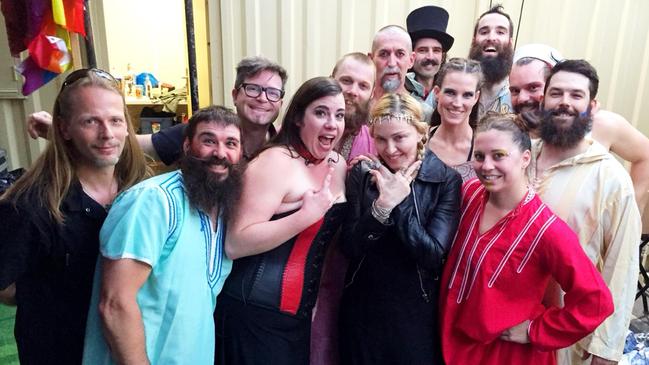
SA Weekend
Don't miss out on the headlines from SA Weekend. Followed categories will be added to My News.
Beloved by stars, acclaimed troupe Cirque Alfonse returns to Adelaide with the Australian premiere of a new show. Co-founderAntoine Carabinier-Lépine tells us what to expect in this Q & A with SA Weekend.
Q How did Cirque Alfonse come about?
A My love for circus started when I was a teenage boy and saw the National Circus perform in Canada. I was transported and knew that’s what I wanted to do. With my parents’ support, I signed up to learn the craft. Fast forward to my dad’s 60th birthday. My sister and I erected a big top tent in our village and put on a show, giving our dad his moment on stage as his present (he had always wanted to be on stage). That’s how Cirque Alfonse started, and 18 years on, we have never looked back.
Q How many people make up the troupe?
A Our troupe is 16 people, mostly acrobats and/or musicians. Most of the troupe is family, with my sister and both our partners,our parents and our four young children (two each).
Q Your dad started in the troupe at 60. Now 78, he performs in one of the show’s most dangerous stunts. How did he get involved?
A My dad has always wanted to perform on stage, but unfortunately never had the opportunity to do so until he was 60. It was wonderful to give him the opportunity then and his skills have developed and grown from strength to strength. To perform as a family, doing the thing we love, honing our skills every day is so rewarding. We’re all very proud of him.
Q How many little people are involved? Can they perform any circus acts as yet?
A There are four young kids on tour with us. Two are mine, and two are my sister’s. They make a cameo performance at the end of the performance to showcase their acrobatic skills. It’s definitely a crowd pleaser moment.
Q What was life like growing up on a farm?
A It was unbelievably special. Our farm is in the middle of a forest, with our closest neighbour more than 1km away. It is serene and magical.
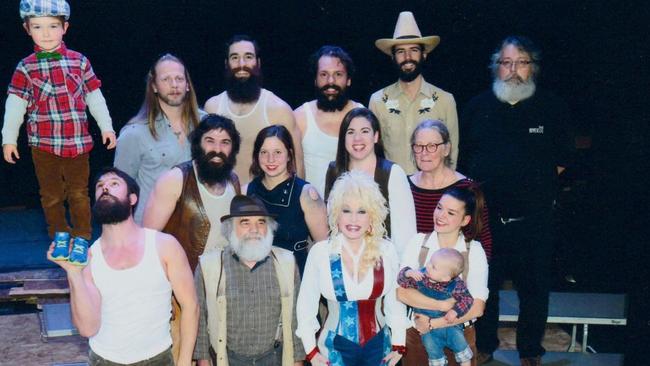
Q What inspired your new show Animal?
A All our previous shows were created on our family farm. It was the perfect place to practise stunts. We would mostly use day-to-day items around the farm as props, to practise our tricks. It would be true to say that Animal naturally evolved over the years because of this, and when it came time to develop a new show, it was a no-brainer. Expect juggling in this show, but with pitch forks and cow bells. Amazing acrobatics, but we use a tractor and, of course, we have the mechanical bull – stunts that all have the wow factor, but have never been seen in this setting. You will never look at rural life the same, with known cliches joyfully turned on their head, married with a touch of irreverence and our wacky sense of humour – I’m sure all ages will love it.
Q What is the most challenging part of travelling together as a family?
A The most challenging part of travelling together as a family is something I think every family can understand; you love each other at the start of a tour, and then it gets a little harder towards the end. That said, we are always grateful that we have a unique opportunity not available to most people. The biggest bonus is that our parents and kids get to have this special time together, travelling the world on our family adventure – it’s pretty cool.
Q How much time do you have apart/tour?
A It depends on the tour, but on average we tour for about six months of the year.
Q Where is home?
A In Canada. For me, it’s Montreal; my parents still live in St-Alphonse-Rodriguez, and my sister is in a small village next to my parents.
Q Animal is premiering in Australia right here at the Adelaide Fringe, but how long has it toured for?
A We have toured this show over the last two years, visiting more than nine countries, performing the show more than 175 times to more than 100,000 people across the globe.
Q What has been your biggest career highlight?
A Madonna came to see our show in London – that was pretty cool. We also performed with Dolly Parton, but the best bit is seeing a happy audience at the end of our show.
Q What do you love about Adelaide?
A Adelaide is one of our favourite cities. This time of the year is so jam packed, creating a unique vibrancy that is unique to your town. The Garden has such an epic Fringe program, plus you have other festivals hitting around the same time like WOMADelaide and the Adelaide Festival, and when you need a break – your beaches and parks are so beautiful and everything is close – so it’s impossible not to soak it all up – we love it.
Q What are your top things to do in Adelaide when not performing?
A We love eating at Africola, we hang at a lot of the Fringe bars and go to the beach. That said, we haven’t been back for five years – so super keen to check out a lot of the new places that have sprung up – especially around Rundle St and theEast End. Our kids are also a bit older this trip – so it opens up new possibilities. We can’t wait to get there.
Cirque Alfonse – Animal, until March 17. The Roundhouse at The Garden of Unearthly Delights. G (1 Warning). adelaidefringe.com.au
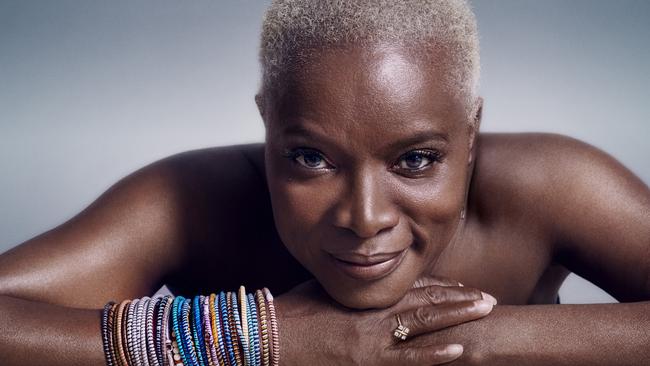
Angélique Kidjo celebrates 4 decades of music at Adelaide Festival
Angélique Kidjo jumps up and down, her arms blurring across the screen when discussing her imminent return to Australia. “We are going to have fun,” she says. “We have to have fuuuuuuunnnnnn, that’s important.”
She’s been a fixture on our shores since 1992, a key attraction everywhere from WOMAD to the Byron Bay Blues Festival. She has a strong, loyal local following.
But one senses this time is different.
Kidjo admits she struggled during the Covid years, particularly being separated from her expanded family, and losing friends and loved ones to the virus.
Then, when the pandemic passed, her beloved mum Yvonne – so full of energy, a “tornado and a tsunami in one” – died suddenly from a brain aneurysm (her father Franck passed away in 2008).
So this trip to a place so familiar might provide some form of catharsis.
“It’ll be three years in June since my mother died … and I think this month (January) has been the first month that I’ve been letting my mom go,” she says.
Does she think she’ll feel her parents’ presence when she takes the stage?
“Yes, I’ll feel their presence, especially my mother,” she says.
“Because the last conversation we had the day before she died, she said she was going to record some songs for me.
“And the next day she was gone.”
Kidjo’s story is well documented. Born to a family of performing artists in what was then known as French Dahomey, her father was a musician who worked in a post office and her mother ran a theatre troupe. She began singing and performing at an early age, raised on a diet of traditional music alongside the likes of Jimi Hendrix, Otis Redding and James Brown.
Due to political conflicts (the communist dictatorship at home wanted her to perform propaganda music), she left for Paris in the early ’80s, toyed with the idea of becoming a human rights lawyer, but decided to stick to music.
She studied jazz,met producer and musician Jean Hebrail, and they married a few years later.
From there her career flourished as she effortlessly merged traditional African music with R&B, funk, jazz, hip-hop as well as bits and pieces from Europe and Latin America.
At last count she had clocked up 16 albums, performed at the opening ceremony of the 2020 Tokyo Olympics, and is a 2023 PolarMusic Prize laureate.
It has been a remarkable journey and one she again says could not have been achieved without her parents, although it was only in later years that she was able to fully appreciate the sacrifice they made for her.
“My parents allowed me to be free to do whatever I wanted to do, they never tried to bring me down, they gave me every support they could financially. Or any kind of way,” Kidjo says.
“When you’re a young girl in Africa and you decide to sing, sexism is just part of the battle.
“You have society against you, the man against you, if you think about it, you want to scream. You want to scream for freedom.
“And because my father and mother have sheltered and protected me and pushed me to be who I wanted to be, I took it for granted for so long.
“I thought it was the norm and the reality kicked in when I became a UNICEF Goodwill Ambassador (in 2002) and started travelling in Africa, where I saw mothers whose dreams have been crushed by early marriage, telling me, ‘We want our daughter to be like you.’
“And then that’s when I started realising what my mom and my dad had sacrificed for their three girls to go to school to have a future.
“My father was under attack all the time.”
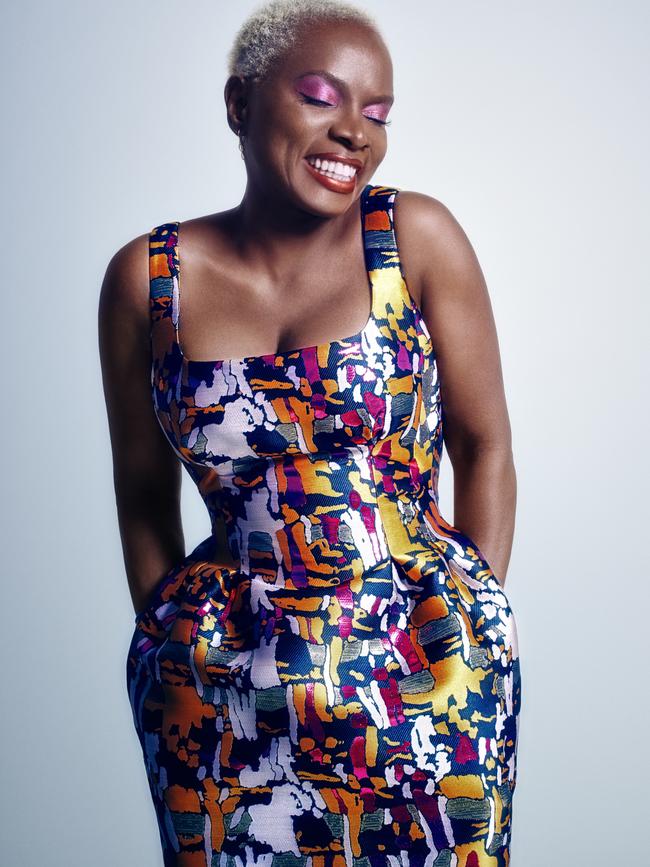
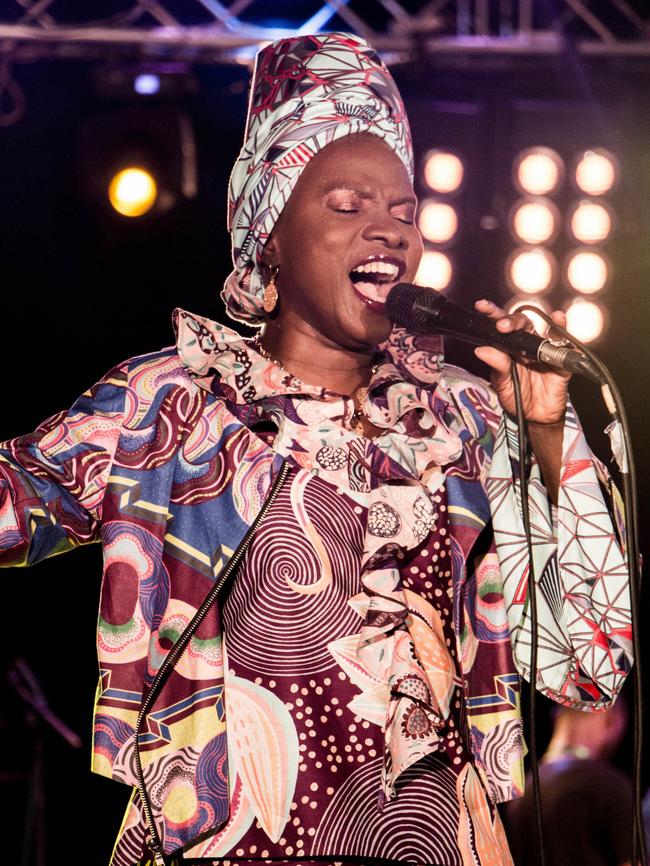
Kidjo pauses when trying to describe what audiences can expect from a tour that will celebrate four decades of music.
How will she choose from a back catalogue of hundreds of songs? How will she whittle it down to do it all justice?
“You know what? I’m just gonna do what I feel,” she says with a laugh.
“I can put something out there and then decide if I want to change at the last minute, and my musicians have played long enough with me to know what to do. Let’s do this. Boom.”
Kidjo understands the milestone, she knows what it means, she knows the people who backed her to get to this point.
There’s also the small matter of a promise she made to her mum during one of their final conversations.
“She asked if I was proud (of my career),” Kidjo says.
“Yes, I said, I think I am.
“She said, ‘Don’t sleep on your achievements. There’s still a lot for you to do. And don’t be bragging about anything. Stay humble.’
Then she said, ‘I want you to promise me, I want you to keep going if I’m no longer here. You’re gonna continue doing this with all your heart.’”
Tears welling, Angélique Kidjo says that’s a promise she’s determined to keep.
Angélique Kidjo, with Maatakitj, Adelaide Festival, March 12, 8pm.
THE EXHIBITION CALLING ALL ADELAIDE BELL LOVERS
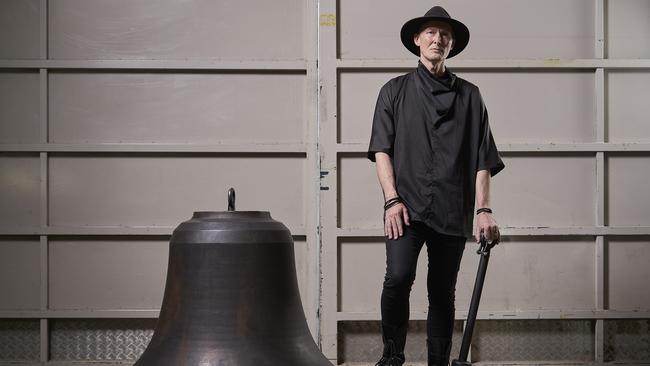
A late afternoon, audience participation bell-ringing session on the opening two days of the Biennial is part of the Proximities sound artwork from Queensland artist, listener, composer and bell ringer, Lawrence English.
On March 1 and 2 members of the public are invited to come to the city and ring their own bells in a guided set-piece led by the large church bells of St Peter’s Cathedral, the Town Hall, Trinity and Scots churches.
For 10 minutes on both days, English hopes a couple of hundred people will join volunteer bell ringers and sound their own bells outside the AGSA on North Terrace.
“Lots of people still have family bells sitting in their houses as an object they never use, so this is a chance, I guess,to reacquaint ourselves with the history of that object in a very collective way,” English says.
“If you are unable to come to the gallery, we are creating a version of the piece that you can do in your home, or out the front of your house.”
English says there were once almost 100 significant bells in Adelaide and as part of the project he has been able to find many that are still functional. “You actually have some of the most active bell ringers in the country here, fantastic ringers who do change ringing (sounding tuned bells in order),” he says.
English, who has a PhD in philosophy and is a composer and recording artist who collaborates with other performers, says his real fascination with bells is with their complex histories which in the past had links to taxation boundaries and labour management.
“One of the reasons there are such large bells in Europe is because the farther the bell could be heard, the larger the taxation zone of that particular town,” he says. “So, if you could hear the chimes of a town bell, you could be taxed by that town.”
In December, English visited Japan where the history of bells, from wind chimes to those sounded in Zen practice, goes back several thousand years, and where bells cast 1200 years ago are in use. They differ dramatically from the European bell and are more closely connected with Buddhist traditions and other spiritual practices.
“Also, I think there is an appreciation of the form, and how a bell just augments space,” he says. “And that is obviously a big interest for me as my practice is about listening.”
Once the public event is over, the focus will shift to a large, new and distinctive bell that English had made by Australian master bell maker, Anton Hasell, the founder of Melbourne’s 39 bronze Federation Bells.
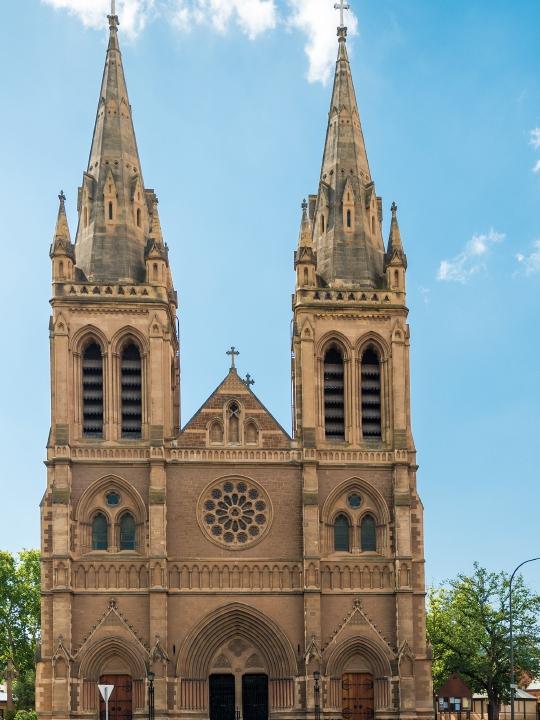
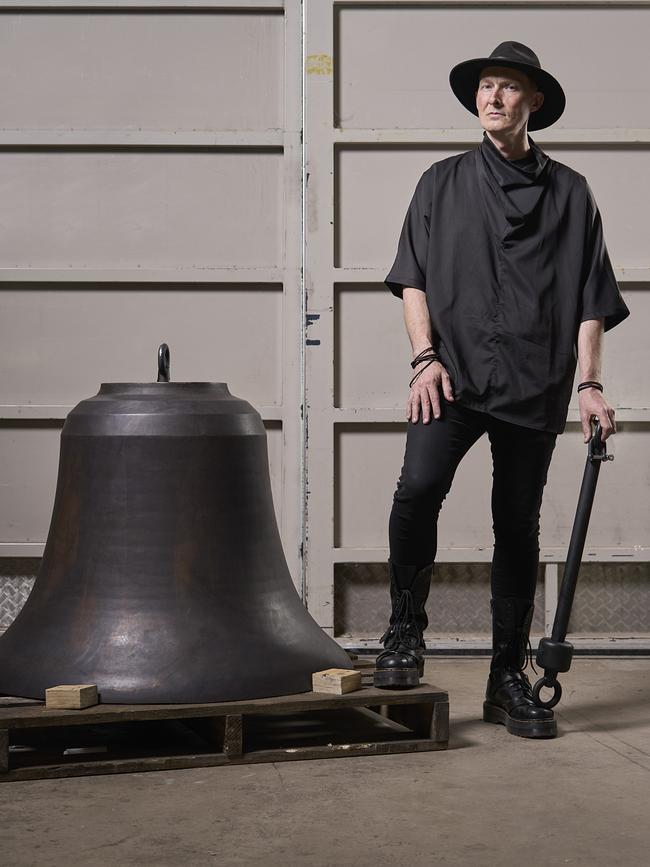
English says Hasell engineered an Australian bell which is harmonically pure and differs from European bells that have a characteristic minor third overtone.
“He has developed this cast of bell which is completely revolutionary, where if you hit the bell, the discernible tone is very clear and there is no minor third,” English says. “So, when I strike that bell you will clearly hear it as a low B flat. The bell has a clarity and resonance that is truly a thing to behold.”
Hasell’s Australian bells, including the Proximity bell that English commissioned, are also a more manageable size, weighing 712kg and a metre in diameter, compared with an otherwise similar European bell at around two tonnes and three times the size.
“It’s a radical redesign of the bell that speaks to me about the desire to make something that is distinctively Australian,” English says.
It is still a big bell and English says when he stood under it at the foundry, he could feel the weight of it. Its size creates an inherent difficulty and explains why there are few foundries left capable of casting it, particularly one made from a3D moulding.
“It took 16 days a side – it is basically cast in half – just to make the cast for the template of the bell so it’s a hugely complicated process,” English says. “As for Anton, we don’t recognise what we have in this person; there are five decades of knowledge there and he is one of the world’s leading bellmakers.”
The blackened, silica bronze bell will be on display in the AGSA as a Biennial exhibit and a special stand was built on which to mount it. English hopes its public exposure will help reposition the bell culturally and let it be experienced as more of a sensory object.
“(A bell is) something that is subjective, something that is temporal and yet will outlive me by many centuries,” he says. “It is something that is only truly alive when we are with it and around it, and when it’s struck.”
The bell will be rung daily and English personally hopes it might take up permanent residence at the AGSA.
“I would love the Art Gallery of South Australia to acquire the bell and for it to live here for the rest of eternity,” he says.
He is hoping to invite the public to come into the gallery and ring it as part of the ongoing Biennial and it will be sounded at the beginning and end of each day by someone from the AGSA. The bell has a nylon clapper to minimise the deafening chaotic clanging quality of some large bells, particularly when heard up close.
“It won’t be the loudest sound, but it will be the richest,” English says. “I can guarantee I will ring it a few times and certainly for the opening weekend.”
For further information about joining the public bell ringing, contact public.programs@artgallery.sa.gov.au
The Adelaide Biennial of Australian Art runs from March 1-June 2 at the AGSA.


